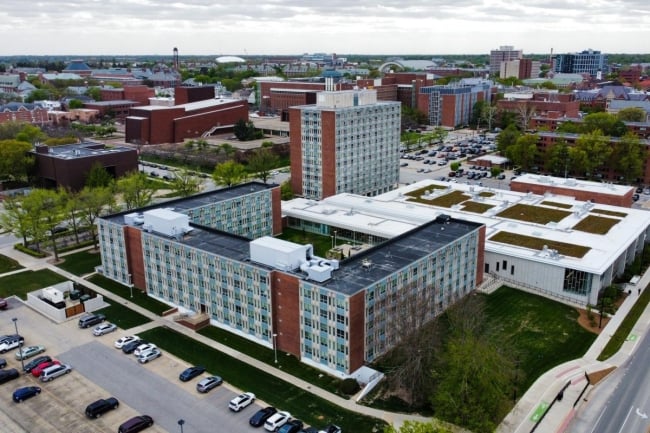You have /5 articles left.
Sign up for a free account or log in.

On-campus housing in UIUC dorms, including the Illinois Street Residence Hall, is in unexpectedly high demand this year, according to university officials.
Another academic year, another set of universities struggling to fit all their students into campus housing.
It’s almost a cliché at this point: Universities miscalculate student housing needs for myriad reasons, ranging from big enrollment booms to unforeseen facilities issues. As a result, students are forced to live in accommodations that can range from quirky to unpleasant, such as dingy dorm basements or cramped hotel rooms.
This year, some administrators have said that the chaotic rollout of the revamped Free Application for Federal Student Aid made matters worse, leading to incorrect projections of how many new students would enroll at their institutions.
“There’s been some unpredictable responses with … the incoming class that we think results from some of the FAFSA issues,” a spokesperson for the University of Illinois at Urbana-Champaign—which took the unusual step of having freshmen share rooms with their resident assistants—told Inside Higher Ed in July.
Michael Fisher, senior director of research for the higher education consulting firm EAB, said many factors can lead to campus housing shortages. Dorms can take years to design, plan and construct, and it’s not uncommon for enrollment to surge before a new residence hall designed to accommodate the influx is completed.
Universities are generally diligent in trying to predict how many students will want on-campus housing.
“They’re [using] a combination of previous years, survey information from prospective students about their likelihood to desire housing and info from community partners about what housing is available in the community and what might change on that front,” he said.
But being off by only a few percentage points can have big consequences—including that they may have too many empty beds, which is just as common a scenario, even if it doesn’t typically make the headlines the way overpopulation does.
“[If] they can’t fill enough beds, they won’t have enough students for their housing operations to break even,” Fisher said.
Altering Residence Halls
As the fall semester begins, some campuses are at least temporarily adjusting their existing housing infrastructure to accommodate the high demand. That might mean placing upperclassmen in dorms designed for freshmen—or vice versa—and housing three students in dorm rooms designed for two.
Both solutions have been adopted at Webster University, a private institution in Missouri, where more than 100 students have been placed in makeshift triple dorm rooms. The university’s student newspaper reported that those students were given discounts on their housing to make up for living in such close quarters; each double room at Webster shares a bathroom with another, meaning that now six students are sharing one toilet and one shower. In addition, a handful of students will live at the Eden Theological Seminary, a United Church of Christ seminary located minutes away from Webster.
The University of Maine’s flagship campus in Orono has taken similar measures, according to WFVX, Bangor’s Fox station. Some doubles have been converted into triples and the lounges in some residence halls, which are intended to be communal spaces, have been converted into temporary rooms. All 173 students stuck in such situations registered or paid for housing late, a university spokesperson told WFVX.
The spokesperson attributed the surge in demand for housing to an increase in enrollment; the university also requires first-year students to live on campus.
Louisiana State University has gone for a more permanent variation on this solution, transforming some of the communal kitchens in its Pentagon Community residential buildings into dorm rooms.
Wait List Woes
Other universities that promised students housing have not been able to accommodate them. At California State University, Monterey Bay, which welcomed a record number of freshmen this year, some students still didn’t have a housing assignment less than a week before classes began, according to KSBW, a Monterey news station.
“No, we didn’t have enough resources given the number of people on a waiting list,” Ben Corpus, the university’s vice president of enrollment management, told the station last month. “That happens at many universities that are popular and competitive. We just have to ask students and families to submit applications earlier.” The university normally requires freshmen to live on campus but was unable to do so this year due to the lack of available beds.
A similar debacle plagued the University of Utah, which, for the first time this year, promised housing to all students who registered by June 5. But according to The Salt Lake Tribune, 22 students were still on the wait list a little over a week before classes started. While wait lists are typically reserved for students who live close enough to commute, one student from Montana told the Tribune that he was instructed to come to campus on the first day of classes, in the hopes that university might find a last-minute room assignment for him.
Paying to Stay Away
Colleges are also asking students who already have room assignments if they would consider living off campus to free up some space. Universities including the University of Illinois at Urbana-Champaign, Louisiana State University, the University of Connecticut and Stony Brook University—which had to close two dorms for repairs due to flooding just before move-in day—have offered students incentives worth thousands of dollars to cancel their housing contracts.
The incentives are usually paired with other solutions, such as placing students in hotels; some returning Stony Brook students will live in a Holiday Inn Express located 3.2 miles from campus.
Kathy Collins, the director on Huron Consulting Group’s higher education and research team, noted that universities should begin thinking about their housing contingency plans about a year in advance. The most important thing for administrators to consider in brainstorming solutions is how their housing contributes to their brand and strategy. A university with a strong focus on growing its freshman class, for example, might want to go to greater lengths to ensure every first-year student can live on campus.
“Universities may want to evaluate, who all do they house? Do they house freshmen, sophomores, juniors and seniors? Do they house graduate students? … Housing, in terms of how you want to house people and who you want to house, has to line up with your mission,” she said.








